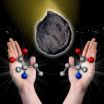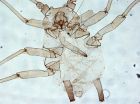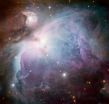(Press-News.org) A wider range of asteroids were capable of creating the kind of amino acids used by life on Earth, according to new NASA research.
Amino acids are used to build proteins, which are used by life to make structures like hair and nails, and to speed up or regulate chemical reactions. Amino acids come in two varieties that are mirror images of each other, like your hands. Life on Earth uses the left-handed kind exclusively. Since life based on right-handed amino acids would presumably work fine, scientists are trying to find out why Earth-based life favored left-handed amino acids.
In March, 2009, researchers at NASA's Goddard Space Flight Center in Greenbelt, Md., reported the discovery of an excess of the left-handed form of the amino acid isovaline in samples of meteorites that came from carbon-rich asteroids. This suggests that perhaps left-handed life got its start in space, where conditions in asteroids favored the creation of left-handed amino acids. Meteorite impacts could have supplied this material, enriched in left-handed molecules, to Earth. The bias toward left-handedness would have been perpetuated as this material was incorporated into emerging life.
In the new research, the team reports finding excess left-handed isovaline (L-isovaline) in a much wider variety of carbon-rich meteorites. "This tells us our initial discovery wasn't a fluke; that there really was something going on in the asteroids where these meteorites came from that favors the creation of left-handed amino acids," says Dr. Daniel Glavin of NASA Goddard. Glavin is lead author of a paper about this research published online in Meteoritics and Planetary Science January 17.
"This research builds on over a decade of work on excesses of left-handed isovaline in carbon-rich meteorites," said Dr. Jason Dworkin of NASA Goddard, a co-author on the paper.
"Initially, John Cronin and Sandra Pizzarello of Arizona State University showed a small but significant excess of L-isovaline in two CM2 meteorites. Last year we showed that L-isovaline excesses appear to track with the history of hot water on the asteroid from which the meteorites came. In this work we have studied some exceptionally rare meteorites which witnessed large amounts of water on the asteroid. We were gratified that the meteorites in this study corroborate our hypothesis," explained Dworkin.
L-isovaline excesses in these additional water-altered type 1 meteorites (i.e. CM1 and CR1) suggest that extra left-handed amino acids in water-altered meteorites are much more common than previously thought, according to Glavin. Now the question is what process creates extra left-handed amino acids. There are several options, and it will take more research to identify the specific reaction, according to the team.
However, "liquid water seems to be the key," notes Glavin. "We can tell how much these asteroids were altered by liquid water by analyzing the minerals their meteorites contain. The more these asteroids were altered, the greater the excess L-isovaline we found. This indicates some process involving liquid water favors the creation of left-handed amino acids."
Another clue comes from the total amount of isovaline found in each meteorite. "In the meteorites with the largest left-handed excess, we find about 1,000 times less isovaline than in meteorites with a small or non-detectable left-handed excess. This tells us that to get the excess, you need to use up or destroy the amino acid, so the process is a double-edged sword," says Glavin.
Whatever it may be, the water-alteration process only amplifies a small existing left-handed excess, it does not create the bias, according to Glavin. Something in the pre-solar nebula (a vast cloud of gas and dust from which our solar system, and probably many others, were born) created a small initial bias toward L-isovaline and presumably many other left-handed amino acids as well.
One possibility is radiation. Space is filled with objects like massive stars, neutron stars, and black holes, just to name a few, that produce many kinds of radiation. It's possible that the radiation encountered by our solar system in its youth made left-handed amino acids slightly more likely to be created, or right-handed amino acids a bit more likely to be destroyed, according to Glavin.
It's also possible that other young solar systems encountered different radiation that favored right-handed amino acids. If life emerged in one of these solar systems, perhaps the bias toward right-handed amino acids would be built in just as it may have been for left-handed amino acids here, according to Glavin.
INFORMATION:
The research was funded by the NASA Astrobiology Institute (NAI), which is administered by NASA's Ames Research Center in Moffett Field, Calif.; the NASA Cosmochemistry program, the Goddard Center for Astrobiology, and the NASA Post Doctoral Fellowship program. The team includes Glavin, Dworkin, Dr. Michael Callahan, and Dr. Jamie Elsila of NASA Goddard.
Images: http://www.nasa.gov/topics/solarsystem/features/left_hand_aminoacids.html
More asteroids could have made life's ingredients
2011-01-20
ELSE PRESS RELEASES FROM THIS DATE:
Robotic ghost knifefish is born
2011-01-20
Researchers at Northwestern University have created a robotic fish that can move from swimming forward and backward to swimming vertically almost instantaneously by using a sophisticated, ribbon-like fin.
The robot -- created after observing and creating computer simulations of the black ghost knifefish -- could pave the way for nimble robots that could perform underwater recovery operations or long-term monitoring of coral reefs.
Led by Malcolm MacIver, associate professor of mechanical and biomedical engineering at Northwestern's McCormick School of Engineering and ...
Stress, anxiety both boon and bane to brain
2011-01-20
MADISON — A cold dose of fear lends an edge to the here-and-now — say, when things go bump in the night.
"That edge sounds good. It sounds adaptive. It sounds like perception is enhanced and that it can keep you safe in the face of danger," says Alexander Shackman, a researcher at the University of Wisconsin-Madison.
But it sounds like there's also a catch, one that Shackman and his coauthors — including Richard Davidson, UW-Madison psychology and psychiatry professor — described in the Jan. 19 Journal of Neuroscience.
"It makes us more sensitive to our external surroundings ...
Identity theft by aphids
2011-01-20
Collaborative research at the University of Guam has people asking: "What IS a species" and entomologists wondering about the relationship between an insect species and the host plant or plants it feeds on.
Western Pacific Tropical Research Center (WPTRC) entomologist Ross Miller has been studying aphids for years and this work has brought him in contact with entomologists in Canada and the US mainland. Aphid systemetist Robert Foottit, DNA expert Eric Maw and aphid authority Keith Pike have been working with Miller on the identification of aphids, particularly the dreaded ...
Stroke rate rises for patients with HIV infection
2011-01-20
While the overall hospitalization rate for stroke has declined in recent years, the numbers have jumped dramatically for patients infected with human immunodeficiency virus (HIV), suggesting they may be up to three times more likely to suffer a stroke than people uninfected by the virus that causes AIDS.
In a paper published in the Jan. 19 online issue of Neurology, Bruce Ovbiagele, MD, professor of neurosciences at the University of California, San Diego School of Medicine and Avindra Nath, MD, of Johns Hopkins University, reviewed a national dataset of all hospital ...
Spike reported in number of people with HIV having a stroke
2011-01-20
ST. PAUL, Minn. – New research suggests that people infected with human immunodeficiency virus (HIV) may be up to three times more likely to have a stroke compared to those not affected with HIV. The study is published in the January 19, 2011, online issue of Neurology®, the medical journal of the American Academy of Neurology.
"Our findings showed that stroke hospitalizations in the United States decreased by seven percent in the general population within the last decade while stroke hospitalizations for people with HIV rose 67 percent," said Bruce Ovbiagele, MD, MSc, ...
Bedbug genetic study finds possible pesticide-resistance genes
2011-01-20
Ohio State University entomologists have conducted the first genetic study of bedbugs, paving the road to the identification of potential genes associated with pesticide resistance and possible new control methods for the troublesome insect, whose sudden resurgence in the United States has led to a public health scare.
The discovery was reported Jan. 19 in the online journal PLoS ONE.
"While bedbugs are poised to become one of the major household pests across the United States in the coming years, we know very little about their genetic makeup and their mechanisms of ...
Hotspots tamed by BEAST
2011-01-20
The secrets behind the mysterious nano-sized electromagnetic "hotspots" that appear on metal surfaces under a light are finally being revealed with the help of a BEAST. Researchers at the U.S. Department of Energy (DOE)'s Lawrence Berkeley National Laboratory (Berkeley Lab) have developed a single molecule imaging technology, dubbed the Brownian Emitter Adsorption Super-resolution Technique (BEAST), that has made it possible for the first time to directly measure the electromagnetic field inside a hotspot. The results hold promise for a number of technologies including ...
UCSF team views genome as it turns on and off inside cells
2011-01-20
UCSF researchers have developed a new approach to decoding the vast information embedded in an organism's genome, while shedding light on exactly how cells interpret their genetic material to create RNA messages and launch new processes in the cell.
By combining biochemical techniques with new, fast DNA-sequencing technology and advanced computer technology, the team was able to examine with unprecedented resolution how a cell converts DNA into RNA – a molecular cousin of DNA that is used in the process of creating proteins that govern most biological functions. And they ...
The Orion nebula: Still full of surprises
2011-01-20
The Orion Nebula, also known as Messier 42, is one of the most easily recognisable and best-studied celestial objects. It is a huge complex of gas and dust where massive stars are forming and is the closest such region to the Earth. The glowing gas is so bright that it can be seen with the unaided eye and is a fascinating sight through a telescope. Despite its familiarity and closeness there is still much to learn about this stellar nursery. It was only in 2007, for instance, that the nebula was shown to be closer to us than previously thought: 1350 light-years, rather ...
Cancer scientists discover genetic diversity in leukemic propagating cells
2011-01-20
(Toronto, Canada – January 20, 2011) – Cancer scientists led by Dr. John Dick at the Ontario Cancer Institute (OCI) and collaborators at St Jude Children's Research Hospital (Memphis) have found that defective genes and the individual leukemia cells that carry them are organized in a more complex way than previously thought.
The findings, published today in Nature (DOI:10.1038/nature09733), challenge the conventional scientific view that cancer progresses as a linear series of genetic events and that all the cells in a tumour share the same genetic abnormalities and ...



